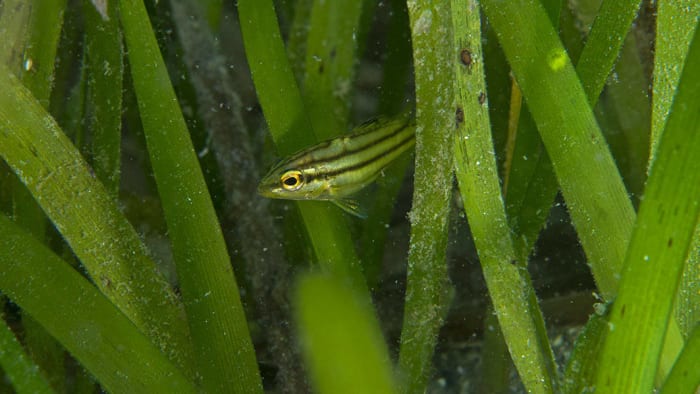 Listen to this article
•
15:34 min
Listen to this article
•
15:34 min
Considered uncharismatic cousins of coral reefs, seagrass meadows are underrepresented in our imaginations. They are often clubbed together and readily confused with seaweeds. However, seaweeds are algae, while seagrasses are true flowering plants, once terrestrial, that have returned to their primordial origins in the sea.
India is a seagrass biodiversity hotspot, hosting 14 of the 72 species found across the globe. They span large tracts of coastal habitats in the Gulf of Kutch, Gulf of Mannar, Lakshadweep and the Andaman and Nicobar archipelagos.
Why should we care about them? Seagrasses provide several critical ecosystem services. Per square metre, seagrass meadows can sequester more carbon than almost any other habitat in the world, second only to mangroves. In a manner analogous to mangroves, seagrasses trap and help stabilise sediments, prevent erosion, and increase the clarity of the waters in which they thrive. They also function as a buffer, protecting coastal regions from the battering of storm waves. Apart from their direct benefits to us, seagrasses provide the foundation for a thriving, interconnected ecosystem in the sea.
Over millions of years, since seagrasses re-entered the sea, marine organisms have coevolved to form a web of complex interactions with them. This includes charismatic mega-herbivores that rely on them for food, species of fish and crabs that seek shelter amongst their leaves, and even the microscopic life on a single blade of seagrass. Fisheries across the globe are sustained by seagrass meadows that provide refuge to juvenile fish. Their disappearance will affect not just the creatures the meadows host but also directly impact coastal communities.
Here I introduce you to some of the unique inhabitants of seagrass meadows of India, showcase their intricate connections with the meadows, and highlight their importance through the case of the lost meadows of Lakshadweep.

Even a small patch of seagrass is a microcosm, thriving with life that goes unseen. Caridean shrimp dart between blades of grass (1), their glassy translucency rendering them almost indistinguishable from the sand. They forage in the detritus of the meadow, working as decomposers in the ecosystem.
Urchins from the genus Tripneustes voraciously feed on seagrass leaves (2). Octopuses slink between patches of sand and rubble (3), continually morphing colour and texture to mimic their surroundings impeccably. They roam the meadows searching for prey like crabs and sea urchins while hiding from larger predatory fish. Photos: Evan Nazareth (1, 3), Dhritiman Mukherjee (2)

Feather duster worms are the filter-feeding benthic (seafloor) inhabitants of the meadows. Sprouting from between blades of grass like miniature fountains of colour, they form tiny currents and use their feathery tentacles (radioles) to filter out microscopic organic matter.
An often-overlooked aspect of seagrass meadows is the epiphytic algae that grow with them. Several species of algae grow almost exclusively on blades of seagrass leaves, giving them a fuzzy appearance. To the seagrasses, these algae can be a boon and bane. The algal growth on the blades of grass protects them from drying out when exposed to air during the low tide; it might even serve as shade to protect meadows in shallow water from harmful solar UV radiation. On the other hand, too dense a coat of algae can inhibit the ability of seagrasses to photosynthesise.
In an almost fractal pattern, the algae on seagrass blades also host various species of microscopic crustaceans. These crustaceans may facilitate seagrass reproduction as underwater pollinators, similar to tiny underwater bees. Photo: Evan Nazareth

Seagrass meadows provide refuge to juvenile fish and act as nurseries. Guitarfish and stingrays turn to shallow waters to breed (1). The shallow waters offer their young refuge from larger predators while providing them abundant molluscs and benthic invertebrates to munch on. The structure provided by seagrass blades attracts tiny fish like these (2) grunters (Terapon sps.) that would otherwise be vulnerable to predators in the open sea. Photos: Evan Nazareth (1), Dhritiman Mukherjee (2)


The case of the Lakshadweep archipelago best illustrates the importance of seagrass meadows to coastal communities. Here, seagrass cover in the lagoons has declined by over 99 per cent since 2005, due to overgrazing by green sea turtles. The Agatti seagrass meadows were depleted over a span of five years, while for Kalpeni was gone in about three years. Little seagrass remains outside of small patches protected by artificial cages.
Although the reasons behind this anomalous mass grazing event remain limited to hypotheses, the ramification is that faunal diversity has all but vanished from these lagoons, leading to a steep decline in juvenile fish. The fishing communities of the islands consequently face drastic reductions in fish catch, especially bait fish used in their tuna fisheries. The loss of the meadows has cost the fishermen an estimated 70,000 rupees per person per year according to a paper published by Rohan Arthur et al in Biological Conservation (2013).
To tackle this conservation dilemma, researchers from the Nature Conservation Foundation have installed “seagrass insurance sites”. These exclosures prevent turtles from accessing small four-sq-m patches of seagrass and prevent the complete eradication of seagrasses by turtles. Once the pressure from the turtles is relieved, these insurance sites might serve as the starting point for the recovery of seagrass meadows in the islands. Photo: Wenzel Pinto













